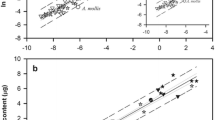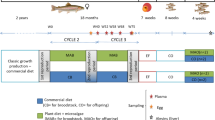Abstract
Aeolidiella stephanieae is a stenophagous tropical nudibranch that feeds exclusively on glass anemones of the genus Aiptasia. These sea anemones usually harbour endosymbiotic photosynthetic dinoflagellates that contribute to the nutrition of their host by providing photosynthetates, such as fatty acids (FA). The present work determined the effect of parental diets on the FA profile of A. stephanieae embryos by feeding breeding pairs of this nudibranch with either symbiotic or aposymbiotic A. pallida. Contrasting FA profiles, namely in the levels of palmitic acid (16:0) and docosahexaenoic acid (DHA, 22:6n-3), were recorded for both parental diets and egg masses produced by nudibranchs eating either symbiotic or aposymbiotic A. pallida. Noteworthy effects of parental dietary FAs on egg masses were also observed, particularly for DHA, which is mainly synthetized by the endosymbionts of A. pallida. Additionally, the present study also highlights how bleaching events may promote cascading effects on the nutrition of marine species with a stenophagous diet, such as A. stephanieae.




Similar content being viewed by others
References
Arts M, Brett M, Kainz M (2009) Lipids in aquatic ecosystems. Springer, New York
Bachok Z, Mfilinge P, Tsuchiya M (2006) Characterization of fatty acid composition in healthy and bleached corals from Okinawa, Japan. Coral Reefs 25:545–554
Burke L, Bryant D, McManus J, Spalding M (2004) Reefs at risk revisited. World Resources Institute, Washington
Carroll D, Kempf S (1990) Laboratory culture of the aeolid nudibranch Berghia verrucicornis (Mollusca, Opisthobranchia): some aspects of its development and life history. Biol Bull 179:243–253
Clarke K, Gorley R (2006) PRIMER v6: user manual/tutorial. PRIMER-E, Plymouth
Cohen Z, Vonshak A, Richmond A (1988) Effect of environmental conditions on fatty acid composition of the red alga Porphyridium cruentum: correlation to growth rate. J Phycol 24:328–332
Cole AJ, Pratchett MS, Jones GP (2009) Effects of coral bleaching on the feeding response of two species of coral-feeding fish. J Exp Mar Bio Ecol 373:11–15
Dalsgaard J, St John M, Kattner G, Müller-Navarra D, Hagen W (2003) Fatty acid trophic markers in the pelagic marine environment. Adv Mar Biol 46:225–340
Hendriks I, van Duren L, Herman P (2003) Effect of dietary polyunsaturated fatty acids on reproductive output and larval growth of bivalves. J Exp Mar Bio Ecol 296:199–213
Hoegh-Guldberg O, Mumby P, Hooten A, Steneck R, Greenfield P, Gomez E, Harvell C, Sale P, Edwards A, Caldeira K, Knowlton N, Eakin C, Iglesias-Prieto R, Muthiga N, Bradbury R, Dubi A, Hatziolos M (2007) Coral reefs under rapid climate change and ocean acidification. Science 318:1737–1742
Kleypas J, Bianucci L, Currie J, Karnauskas M, Logan C, Teneva L (2010) Predicting coral bleaching events: considerations of adaptation rates, natural variability and ocean acidification. In: Proceedings from the 2010 AGU ocean sciences meeting, 22–26 Feb 2010
Leal MC, Nunes C, Engrola S, Dinis M, Calado R (2012) Optimization of monoclonal production of the glass anemone Aiptasia pallida (Agassiz in Verrill, 1864). Aquaculture. doi:10.1016/j.aquaculture.2012.03.035
Lee R, Hagen W, Kattner G (2006) Lipid storage in marine zooplankton. Mar Ecol Prog Ser 307:273–306
Lepage G, Roy C (1986) Direct transesterification of all classes of lipids in a one-step reaction. J Lipid Res 27:114–120
Marshall R, McKinley S, Pearce C (2010) Effects of nutrition on larval growth and survival in bivalves. Rev Aquac 2:33–55
Martínez-Pita I, Garcia F, Pita M (2005) Fatty acid composition and utilization in developing eggs of some marine nudibranchs (Mollusca: Gastropoda: Opistobranchia) from southwest Spain. J Shellfish Res 24:1209–1216
Mike L, Bricelj V, Parrish C (2004) Growth of postlarval sea scallops, Placopecten magellanicus, on microalgal diets, with emphasis on the nutritional role of lipids and fatty acids. Aquaculture 234:293–317
Muscatine L, Falkowski PG, Porter JW, Dubinsky Z (1984) Fate of photosynthetic fixed carbon in light- and shade-adapted colonies of the symbiotic coral Stylophora pistillata. Proc R Soc B 222:181–202
Olivotto I, Planas M, Simões N, Holt G, Avella M, Calado R (2011) Advances in breeding and rearing marine ornamentals. J World Aquac Soc 42:135–166
R Development Core Team (2011) R: A language and environment for statistical computing. In: Computing RFfS (ed) R foundation for statistical computing, Vienna, Austria
Titlyanov E, Titlyanova T (2002) Reef-building corals—symbiotic autotrophic organisms: 2. Pathways and mechanisms of adaptation to light. Russ J Mar Biol 28:S16–S31
Titlyanov E, Titlyanova T, Yamazato K, Van Woesik R (2001) Photo-acclimation of the hermatypic coral Stylophora pistillata while subjected to either starvation or food provisioning. J Exp Mar Bio Ecol 257:163–181
Valdés A (2005) A new species of Aeolidiella Bergh, 1867 (Mollusca: Nudibranchia: Aeolidiiae) from the Florida keys, USA. The Veliger 47:218–223
van Woesik R, Sakai K, Ganase A, Loya Y (2011) Revisiting the winners and the losers a decade after coral bleaching. Mar Ecol Prog Ser 434:67–76
Zhukova NV (2007) Lipid classes and fatty acid composition of the tropical Nudibranch mollusks Chromodoris sp. and Phyllidia coelestis. Lipids 42:1169–1175
Acknowledgments
Miguel C. Leal acknowledges the financial support by Fundação para a Ciência e Tecnologia, Portugal, through grant SFRH/BD/63783/2009. We also thank Sofia Engrola for her support during the culture of Aiptasia, Nancy Tenebaum for her helpful comments and revising the manuscript and to three anonymous reviewers for their helpful comments.
Author information
Authors and Affiliations
Corresponding author
Additional information
Communicated by T. L. Goulet.
Rights and permissions
About this article
Cite this article
Leal, M.C., Nunes, C., Alexandre, D. et al. Parental diets determine the embryonic fatty acid profile of the tropical nudibranch Aeolidiella stephanieae: the effect of eating bleached anemones. Mar Biol 159, 1745–1751 (2012). https://doi.org/10.1007/s00227-012-1962-1
Received:
Accepted:
Published:
Issue Date:
DOI: https://doi.org/10.1007/s00227-012-1962-1




